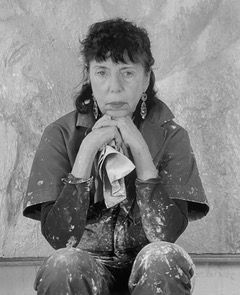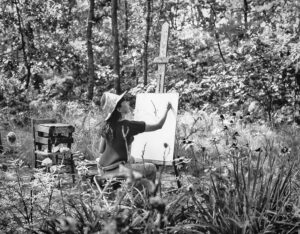The painter Nora Speyer, a founder of the Landmark Gallery in New York City and the Long Point Gallery in Provincetown, died on March 20, 2024 at Grand Oaks Assisted Living in Washington D.C. She was 101.

She and her husband, the artist Sideo Fromboluti, summered and worked in their house on Higgins Pond in Wellfleet from 1967 to 2010. Nora produced a body of work that included impasto oil paintings of large allegorical figures, still lifes, and landscapes.
“My mother was a sensual woman,” Nora’s daughter, Iona, said. “She believed in the power of womanhood, which she expressed through the sexuality of her allegorical female figures, whose bodies are in danger.” In her landscapes, Iona added, “that tension can be felt in the layering of the paint,” in which the serene surfaces of a wood, a meadow, or even a flower are unsettled from below.
Nora was born in Pittsburgh, Pa. on Nov. 24, 1922, although she insisted the year was 1923. Her father, Alexander Krail Speyer, was a businessman and investor who managed to survive the 1929 stock market crash; her mother, Tillie (Sunstein) Speyer, reared their five children.
Nora’s parents were friends with the Kaufmans, who owned Frank Lloyd Wright’s Fallingwater, where she encountered eminent people including Frida Kahlo and Albert Einstein.
Alexander was stern, “an old-fashioned patriarch,” Iona said, and Nora “was willful.”
Before attending Tyler College of Art in Philadelphia, Nora’s art was bold but undisciplined, said Iona. “She found herself at Tyler,” she added. In a letter to her parents at the end of her first year, Nora wrote that it had been “so perfect in a way that one wonders if such can happen more than once in one’s lifetime.”
At Tyler, Nora met Sideo. According to his unpublished memoir, he first saw Nora at a Halloween party where she mimed a strip tease. He was smitten but shy. Nora approached him while he was painting a ceiling mural, and that started a passionate relationship that lasted a lifetime, said Iona.
Nora’s family objected to her boyfriend and took her out of school. In defiance, she cut family ties and followed Sideo to Kansas City, where he was serving in the Army. They married on New Year’s Eve in 1944. “Their marriage certificate still has a lipstick stain on it,” Iona said.
In 1948, Nora insisted that they move to New York City, where they immersed themselves in the artist-run cooperatives of the East Village that encouraged experimentation and were unusually open to women artists.
At first, Sideo supported the family as an illustrator, with Nora as his agent, but after her father died in 1960 she received an inheritance that allowed them to be fully devoted to painting. The family settled in an apartment in Peter Cooper Village, where Nora and Sideo painted from nine to five daily. Nora’s “big fear was not to be taken seriously as an artist because she was a mother,” Iona said. “But she was a fantastic mother.”

In 1954, Nora had her first solo show at the Zena Gallery in Woodstock, N.Y.; in 1959, she had a solo show at the Galerie Faccheti in Paris; and in 1962, she had another in the Stable Gallery in New York City. By the mid-1960s, she was painting on Martha’s Vineyard in the summers. In search of an artistic community, she joined friends in Wellfleet, where she and Sideo built their house.
Nora’s work is in the permanent collections of 22 museums, including the Museum of Modern Art, the Carnegie Museum of Art in Pittsburgh, the National Gallery in Washington, and the Pennsylvania Museum of Art in Philadelphia.
In 2015, the Provincetown Art Association and Museum exhibition “Nora Speyer and Sideo Fromboluti: A Shared Life in Art, 1975-2008” featured Nora’s landscapes. According to the catalog notes, her paintings called “Trees on Patience Brook,” inspired by the view from her Wellfleet studio, “are both calm and expressive; calm from the nature of the place itself and Nora’s sensitivity to it, and expressive from her naturally intense painterly approach to representing place.”
The introduction to Nora’s 2005 exhibition “Death and the Maiden” at the Denise Bibro Fine Art Gallery in Chelsea points to a different tension in Nora’s work. Donald Kuspit wrote: “Nora Speyer is a pure painter as her intricate surface, at once physically raw and emotionally refined, suggests. Her Death is a symbol of Patriarchy and her Maiden of resistance to it.”
Through her family’s foundation, Nora supported PAAM, Castle Hill Center for the Arts, and the Writers’ Workshop. She also had a lasting influence on other artists and writers.
“Most of her paintings were done with expressionist flair, distinguished by a lavish use of paint,” wrote painter Bob Henry in a remembrance. “I was the lucky inheritor of the massive amounts of paint that were left over at the end of each summer season,” he added. Nora and Sideo’s “shared painting practice was amazing,” Henry wrote, “and I and their other friends found their candor refreshing.”
“There was nothing phony about Nora,” wrote art historian Mary Abell in an email. “She was a uniquely expressionistic artist in her figure paintings, which were very emotional and powerful with a strong sense of color and vibrant brushwork.”
Former Long Point Gallery director and poet Rosalind Pace wrote, “I was stunned by her work and wrote a few poems trying to put language to what I saw. Nothing got in the way of her intensity. Nora paid attention. She was beautifully fierce.”
Nora is survived by her children, architect Chris Fromboluti of Washington, D.C. and artist Iona Fromboluti of Brooklyn, N.Y.; grandchildren Sara Fromboluti of Kauai, Hawaii and Matthew Fromboluti of Philadelphia; and two great-grandchildren.



